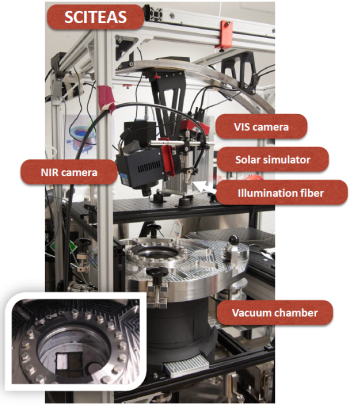BYPASS instruments, techniques and cells
SCITEAS
 The SCITEAS (Simulation Chamber for Imaging Temporal Evolution of Analogous Samples) facility is an original simulation chamber aiming at studying the temporal evolution of icy analogues (of comets and other small bodies, Mars etc.) under low temperature and low pressure conditions Pommerol et al., 2015.
The SCITEAS (Simulation Chamber for Imaging Temporal Evolution of Analogous Samples) facility is an original simulation chamber aiming at studying the temporal evolution of icy analogues (of comets and other small bodies, Mars etc.) under low temperature and low pressure conditions Pommerol et al., 2015.
The chamber
- Cylindrical, 30 cm in diameter and 32 cm high
- Ice samples several centimeters large and thick can be placed inside
- Cooling by circulation of liquid nitrogen in a shroud around the sample (about -100°C)
- Vacuum down to about 10-7 mbar (primary and turbo pumps)
The Imaging System
A quartz window on top of the sample enables to monitor the sample surface evolution with a hyperspectral imaging system positioned outside the chamber.
- Tunable monochromatic light source:
- light from a 100 W Quartz Tungsten Halogen lamp (Oriel 7340)
- dispersed and filtered by a Oriel MS257 monochromator producing the desired monochromatic light from 0.4 to 2.4 µm
- focused on a fiber bundle made of 37 Optran WF fibers (Ceramoptec) to illuminate the sample through the window (or with the chamber open)
- Two cameras on top of the chamber:
- a visible camera (0.38-1.08 µm): 1.4-Megapixel scientific-grade camera (model TSI 1500M-GE from Thorlabs) equipped with a 1392×1040 CCD sensor
- a near-infrared camera (0.85-2.4 µm): Xeva-2.5-300 from Xenics equipped with a 320×256 pixels HgCdTe (MCT) detector cooled by a four-stage Peltier element